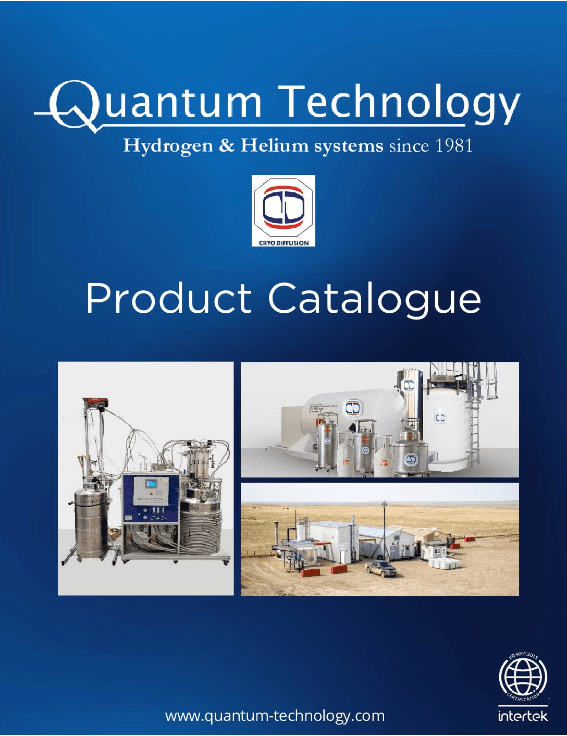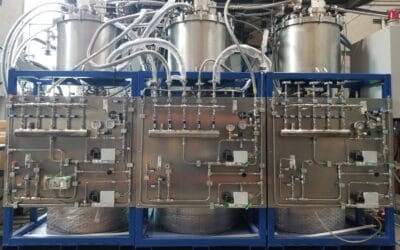PRODUCTS
For 40 years we have been manufacturing premium Helium and Hydrogen liquefaction units, recovery systems and He production plants. We produce standard and custom solutions for any gas recovery, separation, purification and liquefaction.
Discover Our Catalogue Of Helium, Hydrogen and Speciality Gases Products.
Welcome to Quantum Technology’s Product Catalogue! Discover our advanced helium and hydrogen liquefaction units, recovery systems, and custom cryogenic solutions designed to meet your specific needs.
With over 40 years of experience, we offer innovative, cost-effective technologies for gas recovery, purification, and liquefaction. Explore how our proprietary systems can save you up to 95% on helium costs and enhance your operational efficiency. Download our catalogue now to learn more.
HELIUM
Quantum presents a Total Helium Solution, catering to your needs, whether you’re buying, selling, or recovering Helium. Our solutions empower you to save costs and achieve independence from market fluctuations and suppliers.
Recovery and Purification Systems
Our series of QuantumPURE purification systems are designed to run safely and autonomously. You can purify moored airships overnight, secure in the knowledge that the system will operate without intervention and oversight. This allows recovery of lift and minimizes make-up Helium needs.
- Optimized Design: Tailored to fit your operational needs and reduce costs.
- User-Friendly: Simple, designed for one-person operation.
- Portable: Easily transported, with skid or trailer-mounted options.
- Field Serviceable: All valves and seals are replaceable on-site.
- Flexible Power Options: Helium compressor powered by electric or diesel.
- Efficient Venting: Minimizes helium loss during air and water venting.


Helium Liquefiers
We use state of the art, proprietary technology to liquefy helium at 20 litres per day upward of 250 litres per hour. Our custom solutions are designed to suit your specific requirements and include all aspects; N2 liquefiers, automated setup, purifiers, compressors, valves, piping, and more.
We also provide full turn-key systems that recover and purify helium. Our customers see significant helium cost savings upward of 95% when using our full recovery, purification and liquefaction systems.
HELIUM
uantum presents a Total Helium Solution, catering to your needs, whether you’re buying, selling, or recovering Helium. Our solutions empower you to save costs and achieve independence from market fluctuations and suppliers.
HELIUM LIQUEFIERS

Coastal Cleanup
Our solution provides a wide range of tools, features, and functionalities to help your sales organisation.
Goal: $250,000

Marine Education
Our solution provides a wide range of tools, features, and functionalities to help your sales organisation.
Goal: $50,000

Habitat Restoration
Our solution provides a wide range of tools, features, and functionalities to help your sales organisation.
Goal: $150,000
Oceanic Scale
Diving into the Numbers
%

Over 70% of the Earth’s surface is covered by oceans, making them the planet’s largest habitat.

More than 500 coral species can be found in coral reefs, each contributing to the vibrant colors and biodiversity.

Scientists estimate that there are over 1.5 million species yet to be discovered in the depths of the ocean.
Our Coral Reef Restoration project aims to revitalize degraded coral reefs in Miami through a combination of coral transplantation, artificial reef structures, & community involvement.
How You Can Help
Getting Involved
Join the Team
Cultivating resilient coral species in nurseries and transplanting them onto damaged.
Become a Volunteer
Installing artificial reef structures to provide habitat for marine life and enhance the resilience.
Make a Donation
Installing artificial reef structures to provide habitat for marine life and enhance the resilience.




Donate Our Programs
Our Blog
Quantum Technology Secures $500,000 from CICE for Groundbreaking Zero-Boil-Off Liquid Hydrogen Delivery System
[Squamish, BC – November 26, 2024] – Quantum Technology is proud to announce it has been awarded $500,000 in funding from the Clean Innovation and Clean Energy (CICE) program to advance its cutting-edge zero-boil-off liquid hydrogen delivery system project. This...
Quantum Completes the Commissioning of its Largest Helium Recovery System to date at NIST
Quantum successfully completed commissioning of its largest helium recovery system to date at the National Institute of Standards and Technology (NIST), setting a new standard in efficiency and scale. The system recovers helium from over 100 instruments across a vast...
Quantum Hosts Czech Finance Minister to Discuss Green Hydrogen Collaboration
Quantum Technology recently had the honor of hosting the Minister of Finance from the Czech Republic for discussions on green hydrogen initiatives, active partnerships, and future collaborations. During the visit to Quantum’s headquarters in Squamish, key discussions...




